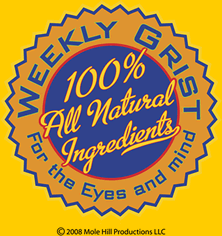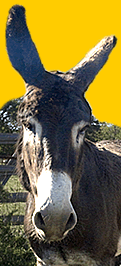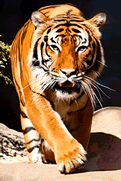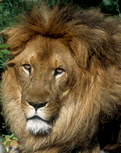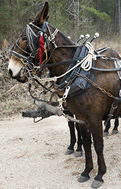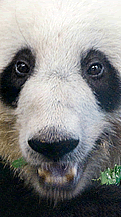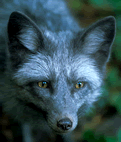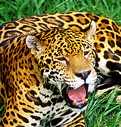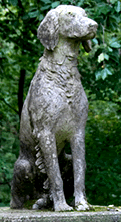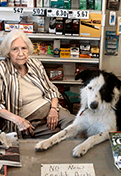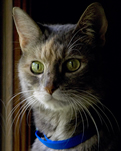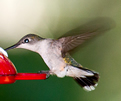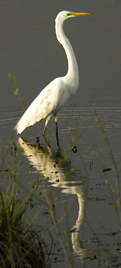|
|
|
|
 |
|
|
|

January Sunbath: Bambi (left) and Blondie are horned, shaggy Scottish Highland cows. Here they bask in unseasonal late January sunshine on Jimmy Michael's farm in Grant County, Arkansas. This is one of the few breeds that keep their horns, according to Jimmy. 
Sunday, January 30, 2011 I was beginning to believe my foray down County Road 77 in Grant County, Arkansas, was going to draw a blank. Then in a heartbeat, my fortune took a giant leap forward. Behold, I rounded a curve and saw cattle. Not just any cattle. Cattle with horns. In this day and time, seeing a herd of horned bovines is highly unusual. In the cattle business, horns have little value, so most cattle are dehorned. At first, like any southern good ol' boy, I figured they were Longhorns, of Texas fame. Taking a second look, I decided the horns were not shaped right for Longhorns. Besides, these cows had a lower center of gravity. There was not a soul on the farm, so I couldn't ask what kind if critters they might be. I shot a few, packed up and moved on. I hadn't gone far when I saw an approaching pickup, so I stopped and rolled my window down. In pickup, that means, "Hey buddy, stop, I wanna talk." The driver was thoroughly familiar with this protocol and responded as requested. "Howdy." "Howdy." "Those your cows back down the road?" "Yep." "What kind are they?" "Those are Scottish Highland cattle." That short, introductory conversation led to more palaver and a plethora of information about Scottish Highland cattle, and how Jimmy Michael, the other driver, had come into the business of raising these fine animals. Turns out Jimmy and his late wife Brenda in the late nineties began planning their retirement and decided that raising cattle would be their key to sanity after the day jobs were abandoned. About that time, Jimmy saw a cover picture of some Scottish Highland cows on Front Porch, a magazine published by the Arkansas Farm Bureau. He read the article, and when Brenda asked him what kind of cattle he wanted to raise, he showed her the magazine cover and said, "These!"  Clint, one of the friendly local bulls, checks me out through a barbed-wire fence, more appropriately known as "bob-wahr." At the time I shot this picture, I was not aware of his docile nature and was grateful for the fence. Scottish Highland cattle, according to some authorities, have the endurance of a Yak and the temperament of your favorite dog — fortunate indeed if you weigh nearly a ton. Jimmy and Brenda worked side-by-side building fences and getting the property in shape to be a proper home to their new herd. They contacted the Scottish Highland breeder from the magazine story and bought their first two cows. As time went on, they bought more stock, including Clint, their big black Scottish Highland bull. They drove to Murfreesboro, Tennessee, to get him, a trip of more than 400 miles one-way.  "The cattle kept me going," says Jimmy Michael, referring to the time after his wife's untimely death. From all outward appearances, it is a mutual admiration society between the cattle and Jimmy. The herd was building and the Michaels were looking forward to their retirement. And then in February of 2003, Brenda passed away. Jimmy's plans were shattered, but with a stiff upper lip, he continued to work on the farm and at his job as an instrument electrician at a nearby paper mill. "If it weren't for the cattle, I don't believe I would have made it," he says. In the ensuing time, Jimmy retired, so now the cows are his day job. Jimmy's herd now numbers 52 cattle: two bulls and the balance cows, calves, and heifers. He has a website and is gaining a reputation as a responsible breeder of Scottish Highland cattle. His cattle also value his company. When he arrives on the farm, they make their way toward him. He knows them by name. Jimmy Michael takes life on life's terms and plays the cards that were dealt him. He deserves our admiration. N O T E S:
Most of the time, there is more to the Photo of the Week story than can be told in an essay. And most of the time there are more pictures to be seen. Presuming that some folk will enjoy being privy to this trove of information, I have created a blog, “Weekly Grist for the Eyes and Mind,” where I am showing and telling “the rest of the story." There are also some blatantly commercial mentions of some of the things we do to earn our beans and taters. Click on the Weekly Grist logo and go to the blog. — J. D.
 |
|
|
|
|
|

|
|
|
|
CornDancer.com is the personal website of Dr. Freddie A. Bowles and Ebenezer Baldwin Bowles.
CornDancer has participated in the World Wide Web since 2000. Submissions are invited. Contact webmaster at threadspinner@corndancer.com |
|
|
|



